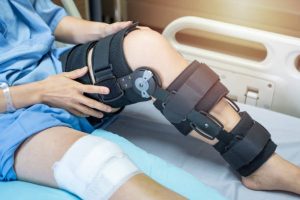Athletes the world over will tell you about the symbiotic relationship they have with their bodies; it’s a partnership where both mind and physical form must act in harmony to achieve incredible feats. However, even the most well-maintained bodies are susceptible to wear, tear, and injury. Enter the realm of orthopaedic sports surgery—where science meets athleticism to heal, enhance, and restore.
The roots of orthopaedic sports surgery are humble, beginning with simple procedures and evolving into the sophisticated field it is today, thanks to relentless hard work and ingenuity from the medical community. Athletes, those sculpted titans who seem almost superhuman, are the most common patrons of this medical speciality. Their physical prowess often puts them at risk for injuries that only these cutting-edge surgical advances can heal.
In the decades gone by, sports surgery was a field fraught with lengthy recovery times and uncertain outcomes. Innovation and a better understanding of human anatomy have paved the way for a reduction in invasive procedures and improvement in healing times, propelling an athlete’s journey from injury back to peak performance.
Facing the Field: Types of Sports Injuries
Contents
- 1 Facing the Field: Types of Sports Injuries
- 2 Progressive Procedures: Recent Advancements in Sports Surgery
- 3 Arthroscopy and Beyond: Advancements in Arthroscopic Surgery
- 4 A Shift in Healing: The Emerging Role of Regenerative Treatment in Athletic Surgery
- 5 Empowering Surgeons: The Surgeon’s Enhanced Toolkit
- 6 Ethical Scorecards: Criticisms and Considerations
- 7 What Tomorrow Holds: The Future of Sports Surgery

The world of sports, with its diverse range of activities, also comes with a spectrum of injuries that can stop athletes in their tracks:
- Sprains and strains
- Tears of the ligaments (such as the ACL or MCL)
- Meniscus injuries
- Fractures and dislocations
- Tendinitis
Orthopaedic sports surgery steps in as a crucial player when these ailments surpass the scope of RICE (rest, ice, compression, elevation) therapy and other less invasive treatments. The role of surgery is not just to repair, but also to enhance the natural healing process and strengthen the affected area against future injury.
Each sport has its common injuries; for example, baseball often leads to rotator cuff injuries, while soccer is notorious for causing ACL tears. The key aspect here is that each type of injury requires a carefully crafted surgical approach, tailored to the sport’s specific demands and the athlete’s body. This customization is part of what makes modern sports surgery so effective.
Progressive Procedures: Recent Advancements in Sports Surgery

Advancements in sports surgery in recent years have been nothing short of exceptional. Surgeons now employ innovative surgical techniques that are less invasive, reduce post-operative pain, and shorten recovery periods. This means athletes can envision a return to their passion much quicker than in the past.
These breakthroughs aren’t just technical—they also involve holistic approaches, integrating advanced rehabilitation protocols that begin almost immediately after surgery. These protocols are devised to work in tandem with the biological repair processes of the body, thereby enhancing recovery. It is an approach that recognizes the athlete as more than just their injury, considering their overall physical and mental well-being.
Early detection and preventive measures play a significant role in the realm of sports surgery as well. Technological advancements, such as high-resolution imaging and biomechanical analysis, now assist in identifying potential issues before they intensify. With sports surgery, the adage ‘prevention is better than cure’ truly finds its footing. Early interventions can prevent the escalation of injury, thereby avoiding the need for surgery altogether or at the very least ensuring that if surgery is necessary, it is as timely and successful as possible.
Arthroscopy and Beyond: Advancements in Arthroscopic Surgery

Arthroscopic surgery—a procedure where tiny cameras and instruments are inserted into a small incision—has become the gold standard in treating many sports-related injuries. Its precision means surgeons can have a clear view of the damage without the need for large, invasive cuts, preserving as much of the body’s natural structure as possible.
From the knee to the shoulder and other joints, advancements in arthroscopic surgery have had a profound impact on the way injuries are managed. These improvements mean that:
The likelihood of infection and resulting complications is greatly minimised, while the duration of hospitalisation and the period of rehabilitation experience considerable declines. Furthermore, the ultimate results, including the prospects for resuming athletic pursuits, receive a tremendous enhancement.
Cutting-edge developments in the realm of arthroscopic surgery have been instrumental in elevating outcomes for particular injury types, perpetually honing both the instruments and methodologies in use. Instances such as anterior cruciate ligament (ACL) reconstruction demonstrate the advantages gained from enhanced sewing techniques and the implementation of bioabsorbable materials. These innovations remain pivotal for competitors across the spectrum of sports.
A Shift in Healing: The Emerging Role of Regenerative Treatment in Athletic Surgery

Regenerative treatment stands out as a particularly intriguing frontier in the surgical treatment of sports-related injuries. While conventional surgical approaches have traditionally involved repairing or replacing compromised tissues or modifying physiological structures, regenerative treatment beckons to tap into the innate recovery processes of the human body to mend and augment injured tissues.
The exploration of tissue engineering and stem cell application has unearthed novel paths for addressing injuries resulting from athletic activities. These scientific breakthroughs are transforming the landscape of recovery by:
- Amplifying the body’s natural restorative reaction
- Curtailing the necessity for more pivotal surgical interventions
- Introducing optimism for damages previously considered to preclude continued athletic careers
Additionally, the introduction of growth factors—proteins that hasten cellular proliferation—has ushered in an era where the reconstruction of tissue progresses from a speculative fiction narrative into tangible reality. With each mended muscle or restored joint made possible by these pioneering therapies, medical science edges closer to an unprecedented plateau in sports healthcare provision.
Empowering Surgeons: The Surgeon’s Enhanced Toolkit

Robotics and computer-assisted surgery represent a transformational leap in the surgeon’s toolkit. These advancements minimise human error and heighten precision, uncovering new possibilities in surgical treatment. Significant progress has also been made in the development of customizable implants and prostheses, which are designed to match an individual’s unique anatomy, providing a personalised approach to orthopaedic care.
The enhanced toolkit includes:
- Sophisticated software for preoperative planning
- Robotics that assist surgeons in executing extremely precise procedures
- Advanced prostheses that are tailored for a perfect fit and imitate natural motion
The focus has also shifted towards materials that are more durable and compatible with the human body, helping implants and repairs to last longer and perform better. These innovations symbolise a new era in surgery where the focus is on restoring athletes not just to their former capabilities, but to reach even greater levels of performance.
Ethical Scorecards: Criticisms and Considerations

Despite its many victories, the field of sports surgery is not without its criticisms and ethical considerations. Potential risks or drawbacks are intrinsic to any surgical procedure, and sports surgeries are no exception. As techniques grow more sophisticated, so does the need for diligence in addressing these concerns.
A few of the potential issues include:
- Over-reliance on surgery when conservative treatments might suffice
- Access to these cutting-edge treatments may be limited, raising questions of equity in athlete care
- The psychological impact on athletes when returning to play post-surgery
Ethical considerations also come to the fore, especially in the use of treatments like stem cells and gene therapy, where regulatory frameworks might still be catching up with the pace of scientific discovery. Open dialogue and ongoing research into the long-term effects and ethical implications are vital as the field advances.
What Tomorrow Holds: The Future of Sports Surgery

The horizon of sports surgery is a canvas of endless possibilities, with researchers and practitioners painting increasingly complex pictures of a future where limitations fade into the annals of history. Predictions for the next wave of advancements unveil a landscape where emerging technologies like nanotechnology, bioprinting, and even artificial intelligence may play leading roles.
These technologies have the potential to:
- Further minimise the invasiveness of procedures
- Enhance the precision and efficiency of surgeries
- Revolutionise rehabilitation through virtual reality and augmented training techniques
This is a destination where the prevention and treatment of injuries are seamlessly integrated into an athlete’s routine, aided by wearable technology and real-time analytics. The potential impact on not just elite athletes, but also on the average person, is enormous, pointing to a future where everyone has access to better, smarter, and more personalised orthopaedic care.

